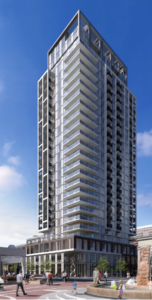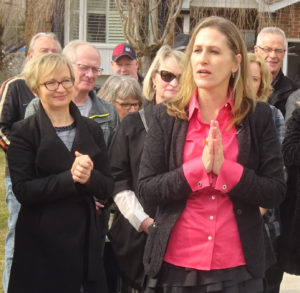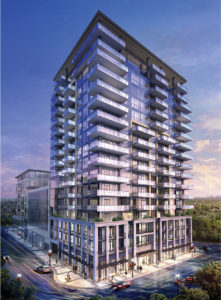 By Pepper Parr
By Pepper Parr
April 23rd, 2018
BURLINGTON, ON
City council is going to consider community benefits, which are set out in Section 37 of the Planning Act, at a city Council meeting this evening.
Community benefits are an agreement a city signs with a developer who has been given more height and density for a project that asked for a zoning and or Official Plan amendment.
The agreement the city planning department arrived at with Carriage Gate, the developer of a 23-storey tower on Brant Street opposite city hall, has a number of people wondering why there isn’t all that much for the community in the agreement.

The benefits the community is to get for the added height and density doesn’t seem balanced to some people.
The tower was approved by council last November, on a 5-2 vote and gave the developer almost double the existing OP heights of 12 storeys (on the James/Brant corner of the property only) and 4-8 storeys on the balance of assembled lands.
There will be several motions from the ward Councillor who wants to modify staff’s proposed Section 37 Community Benefits.
Marianne Meed Ward will also raise what she calls the “larger issue” of how the city handles the use of Section 37 Community Benefits.
Meed Ward doesn’t think residents are getting a good deal and will be referring her colleagues to an alternative model she thinks the city should explore – Community Benefits Agreements.
According to Meed Ward, they are used in Toronto and elsewhere in Canada and the United States. She supports using CBAs instead of Section 37 because they give residents a seat at the table.
Meed Ward points out that Section 37 Community Benefits are only available if council grants height and density above the Official Plan and Zoning Bylaw. Burlington residents want their council to respect the Official Plan and the Zoning bylaw.
Meed Ward argues that “ Section 37 Community Benefits represent only a fraction of the value uplift of the extra height and density granted to the developer. The calculation of benefits is based on the difference in value of the land at the current OP/Zoning permissions, and the amended OP/Zoning permissions. Then a factor of about 25% of that value is applied, to represent the city share. Community benefits are not based on the market value of the new units.”

Marianne Meed Ward announcing her decision to run for the office of Mayor earlier this month.
Third, said Meed Ward “Section 37 Community Benefits can be either cash or “in-kind” benefits, both of which are used for 421 Brant. What gets included in the in-kind benefits are often things that in my view should be a standard part of any application or be provided via the city’s budget — such as public art — rather than having to exceed our OP/Zoning to get these items.”
Fourth, Meed Ward says “the cost of Section 37 Community Benefits are often passed on to purchasers. This has happened in at least two developments I am aware of: the ADI mid-rise on Guelph Line, and the Molinaro development on Maple, where residents were required to pay $1 million to buy the Geo Thermal System. This pass-through of costs erodes affordability, something we’re told is a goal of high-rises in the first place.”

Councillor Meed Ward wants public representation at the table when community benefits for increased height and density are being negotiated.
Meed Ward’s fifth point is that “residents don’t have a seat at the table when negotiating Section 37 Community Benefits. These discussions take place behind closed doors between staff and the developer. The Ward councillor is consulted, but also doesn’t have a seat at the table, and their input can be ignored. Staff develop a proposal for benefits for council consideration; the public consultation kicks in when the report comes to Committee and Council for approval. Residents are forced into a reactive posture, rather than working together to get the best outcome. During the public discussion residents can ask for changes; council members can bring motions for changes.
Meed Ward believes that “granting extra height and density on any property fuels land speculation, which increases property values and tax assessment. That’s because properties become priced not at the current OP/Zoning permissions, but at the new height/density granted.
“This erodes the value uplift used to calculate Community Benefits, as land is priced assuming whatever was granted under an OP/Zoning amendment will be granted in future. So residents get a smaller amount of the pie.
She adds that “the Municipal Property Assessment Corporation takes land value into account when assessing properties for tax purposes, so residents and businesses face spiraling tax assessments. In the downtown, that is passed on to business owners, increasing their cost of doing business.

The Berkeley under construction on Maria at John Street is close to being topped off.
Seventh, Section 37 Community Benefits are voluntary — a developer does not have to agree with them — and can be renegotiated later via a council vote. We’ve already seen this occur with the Carriage Gate development at Caroline/John/Maria/Elizabeth (the same developer as for 421 Brant St). The original proposal included a community benefit of roughly 75% affordable units, calculated at Halton Region’s affordable housing rate.
This was later renegotiated via a council vote of 6-1 to roughly 25-30% affordable units. Meed Ward said she did not support the change.
“With all these drawbacks, Section 37 Community Benefits aren’t the community benefit they propose to be” said Meed Ward and adds that there is an alternative — private Community Benefits Agreements.
Meed Ward is Councillor for ward 2 and a candidate for the Office of Mayor in the October municipal election.


















When it comes to affordable housing – just what is affordable? Who decides who purchases these units? What prevents them from being resold at a profit?
What I would prefer to see is reasonable market rate rentals for the commercial units going into these new high-rises as a Community Benefit. That would be a true benefit to the community. It would allow smaller entrepreneurs to establish businesses and keep the character of Brant Street.
What we need to be doing is building communities not just high rises. We cannot be a walkable community if the services needed for every day living are not within the area. This is one of the reasons people are moving back to the downtown cores – so that they don’t have to get into their car to shop, dine and socialize.
I would like to know what is Halton Region’s affordable housing rate? Is it really affordable?